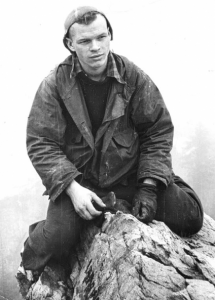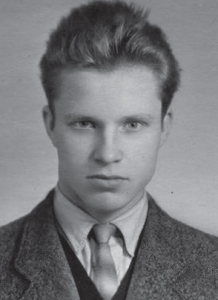

Ryan Sprague
Imagine being trapped on top of a mountain in below-freezing temperatures, no food to eat, no help on the way, and the cold hard truth that death was right around the frigid corner.
It is truly the stuff of nightmares when you are nestled in your warm bed with the covers drawn snuggly over your body and the room filled with a comfortable heat pumping from the furnace. But imagine, even worse, the thought that while trapped in this nightmare scenario, your eventual death would never truly be solved. Your legacy would be frozen in a block of both tragedy and complete mystery. A mystery that was all to real for a group of Russian mountaineers who hiked the Ural mountains in 1959, prompting one of the most gruesome and tragic discoveries in the last half century.

Igor Dyatlov
It was January 25th when twenty-three year old Igor Dyatlov assembled the crew that consisted of three engineers and seven students. The students, highly athletic skiers from the Ural Polytechnic Institute, set off on a training expedition, preparing themselves for an even more ambitious trip to the Arctic regions in the coming months. As days passed, the group made modest headway. But it soon became clear that they’d deviated west in the wrong direction for quite some time due to worsening weather conditions and decreasing visibility. It was on February 1st that one of the team members, Yuri Yudin, decided to stay behind in the nearby settlement of Vizhai, due to illness. Little did Yudin know, this decision would ultimately spare his life.
The rest of the team set up camp on a nearby mountain called Kholat Syakhl, or better known to the indigenous Mansi tribe; Mountain of the Dead. The decision to set up camp here has remained questionable for some time now, many questioning why they hadn’t hiked about a mile more to a slightly warmer and less dangerous open space at the face of the mountain. In 2008, in an interview with The St. Petersburg Times, Yudin himself would defend the decision by Dyatlov and the team, postulating that he “probably did not want to lose the distance they had covered, or he decided to practice camping on the mountain slope.”

Yuri Yudin
Either way, the decision to set up in the forested area would prove disastrous as the days trickled by and no one, including Yudin, had heard anything from the team. As more and more time passed, the families of the members became progressively concerned. A few days off course was typical for such expeditions, but when more than a week slipped by with not a single telegram or distress call, family members demanded a search and rescue operation by the Ural Polytechnic Institute be put into action. When they failed to produce any results on the ground, local military helicopters were sent out to search for the team. It wasn’t until February 26th that the first helicopter pilot would spot something on the ground near the campsite in the forest.
What the first set of investigators found was puzzling. The campsite boasted a large tent that the entire team presumably shared, that appeared to have been cut apart from within. One of the members of the Polytechnic Institute, Mikhail Sharavin, accompanied the investigators. He would later explain what he first witnessed when they approached the campsite. “We discovered that the tent was half torn down and covered with snow. It was empty, and all the group’s belongings and shoes had been left behind.” This observation continued with investigators noting at least eight sets of footprints leading from the tent, all the way to the treeline. Two other pairs of footprints, completely barefoot, were followed to a large pine tree some 1,500 feet away from the tent. Under the tree, Sharavin saw the remains of a fire. But what he saw next sealed the fate of at least two of the members. There, in the snow, were the bodies of Georgyi Krivonischenko and Yuri Doroshenko, both naked save their underwear. Investigators would also note later on that the pine tree had fragments of both men’s skin about fifteen feet or so up in the branches and bark, postulating that they’d tried to climb the tree to no avail. What exactly were they attempting to escape from? With no trace of animal prints anywhere, their lack of clothes, and the fact that they’d had time to start a fire under the tree made the investigators even more puzzled. These were only the beginning of never-ending questions as the investigators uncovered more and more gruesome evidence of the remaining team members.
CLICK HERE TO SUPPORT JIMHAROLD.COM THIS HOLIDAY SEASON – SHOP OUR SPONSORS & AFFILIATES
About 1,000 feet from this scene lay another gruesome sight. In the wintry terrain lay the body of Dyatlov himself. One hand clung firmly to a nearby tree, while the other hand, frozen with ice and rigor mortis, was wrapped around his head in a protective manner. Could he have been trying to stop whatever it was that Krivonischenko and Doroshenko were possibly trying to take refuge from? Not far from Dyatlov was the body of Rustem Slobodin, face down, with a large gash in the side of his head. Furthest from the others was the body of Zinaida Kolmogoro. Traces of blood were found around her body, yet no signs of struggle were apparent. The five deaths were all eventually attributed to hypothermia, but it wouldn’t be until two months later, when the terrain thawed out, that the remaining members would be found.

The Ravine
It was now May 4th. About 250 feet away from the camp site, in a half frozen ravine, the bodies of Alexander Zolotaryov, Nicolas Thibeaux-Brignollel, Alexander Kolevatov, and Ludmila Dubinina were discovered. All four had suffered severe internal injuries, though no outward trauma, bruises, or even tissue damage seemed to be apparent. Local doctors were quoted as saying that the internal damage was “equal to the effect of a car crash.” Perhaps the most disturbing was that of Dubinina, who was found with her head tilted severely back and her mouth gaping wide, her tongue ripped completely out and missing. Things only spiraled further into obscurity. All four seemed to have swapped various items of clothing with one another, including items from the two men found mostly naked under the tree where the fire had been set up.
As if things weren’t strange enough, further investigation would conclude that most of the deceased were found with heavy amounts of trace radiation on their clothes. Several family members, at the funerals of the deceased, would eventually claim that the bodies of the dead bore a rather odd orange color. The hair of the dead has also lost its pigmentation, turning a dull grey. Too many questions circled the mountain in the aftermath of the almost unimaginable discovery of the dead. It was quite clear that something truly tragic had occurred to the team, and as the families began to grieve, the investigators tried desperately to string a timeline together in terms of just what may have happened on the mountain that fateful day. Some hope of doing so came in the form of several rolls of film and diaries that were found in the damaged tent.

The Ill-Fated Mountaineers
The photos developed from the rolls of film revealed that the expedition members had indeed set up their campsite on February 2nd, at approximately 5:00 pm. The first photo showed the members looking very happy and healthy. Taking into consideration the digestion of food in several team member’s bodies, investigators were able to conclude that they’d eaten a meal sometime around 7pm that night and most likely went to sleep some hours later. Because of this apparent meal, forensic pathologists were able to estimate that whatever had led to their deaths happened between 9pm and midnight leading into February 3rd, based on the undigested food found in their stomachs.
Because of the knowledge that the experienced team possessed, whatever happened that night must have sent them into a complete frenzy, fearing their lives were in great danger. While they all fled in several directions, it was also presumed that they all met under the tree where Krivonischenko and Doroshenko had been found. Perhaps they’d all started the fire together, and the two attempted to climb the tree to look for help, eventually failing. This would lead the others to eventually seek other paths for possible rescue from whatever seemed to be the catalyst of the tragic events. With Dyatlov missing at this point, the others had possibly began a trek back towards the tent. This is when they fell into the ravine and were unable to get out
 The events of February 2nd would lead officials to close off this pass from any other outdoorsmen, fearing that whatever occurred that night could possibly happen again. It remained closed for almost three years afterwards. The case was suspiciously closed by investigators, and any documents pertaining to the events were shipped off to a Soviet agency that has yet to be uncovered. To this day, no declassified files have ever been released on what happened on the mountain. But that didn’t stop civilians from coming up with their own theories as to what may have sent the team into a panic and caused their untimely deaths.
The events of February 2nd would lead officials to close off this pass from any other outdoorsmen, fearing that whatever occurred that night could possibly happen again. It remained closed for almost three years afterwards. The case was suspiciously closed by investigators, and any documents pertaining to the events were shipped off to a Soviet agency that has yet to be uncovered. To this day, no declassified files have ever been released on what happened on the mountain. But that didn’t stop civilians from coming up with their own theories as to what may have sent the team into a panic and caused their untimely deaths.
One theory was that while wandering this certain area the day prior, the skiers had unintentionally run into the indigenous Mansi tribesmen, who in their Siberian native ways, didn’t react too kindly to visitors trespassing on their territory. They took matter into their own hands and attacked the skiers, a brutal game of hunter and prey occurring. But investigators were quick to dispel these rumors, stating that no trauma from humans caused the deaths of the skiers and their leader. This would lead to theories that, if not human, something other-worldly could have had a rather alien hand in the fate of the team.
Lev Ivanov, the lead Soviet investigator on the case, interviewed a group of nearby hikers who were in the area when the incident supposedly occurred. A respectable thirty-two miles away, the hikers reported a cluster of “strange orange spheres” in the sky that night. This was also reported by other witnesses in the area for the next few months after the event. Ivanov, in his later years, admitted that he himself believed that the orange spheres in the sky may have been the cause of the Dyatlov team’s demise, or at least had something to do with it, speculating that one of the skiers may have witnessed the UFOs, panicked, and sent the others into a similar frenzy. Many also theorize that a possibly UFO could have caused the orange color to the skin found on the bodies, the grey hair, and even the trace radiation found on their clothes. And while the alien theory seems to be the most unlikely, some look a bit more in the cryptid realm for a possible answer.
While many areas boast their own version of a hominid-like creature, Siberia reigns as one of the most popular with its own Siberian Yeti knows as an “Alma”. Perhaps the creature had infiltrated their tent and sent them running for their lives. This theory hold very little weight, however, as no clear footprints, other than those of the deceased, had been found anywhere near the scene of the deaths. But one interesting piece of evidence couldn’t keep this theory completely out of possibility. Supposedly, a piece of paper near the campsite was found that simply read: “From now on we know there are snowmen.”

Dyatlov Pass Memorial
Other various theories have been brought forth, involving top secret government projects being tested in the area, and even the possibility that the skiers had mistaken harsh winds and unattributed noises to an avalanche. This would presumably prompt them to frantically escape the tent and seek refuge. However, one would suspect that, once again, these knowledgable skiers and their leader would have been fully aware, as they looked behind them, that no avalanche activity was in sight. As for the government experiments? This can’t be completely ruled out, as many investigators have alluded that teams were sent in to investigate long before the camp was said to have originally been discovered with the grisly scenes of death. An extra pair of skies, and even fabrics from a military-like uniform had been found near the campsite. But just like the other theories before these, none of this can irrefutably be proven, once again leaving us to spin our imaginations into overdrive in terms of a possible answer to this tragedy.
Perhaps the word: tragedy, should be the focus of this entire event, more than the mystery that lay behind it. Besides the memories of friends and family, a rusted plaque and memorial stone remain the only physical remembrance of those who lost their lives that day. It is truly a horrific set of events that caused the deaths of those on the Dyatlov Pass. Perhaps it could best summed up by the late Yuri Yudin, the only member who dodged the terrible fate that night. In the same 2008 interview he took part in about the incident, he stated: “If I had a chance to ask God just one question, it would be, ‘What really happened to my friends that night?’”
Photo Credit: The Dyatlov Foundation
– – –
Ryan Sprague is an investigative journalist, focusing on the topic of UFOs. He is the author of the upcoming book, “Somewhere in the Skies: A Human Approach to an Alien Phenomenon”, published by Richard Dolan Press. He is also the co-host of the podcasts, Into the Fray and UFOmodPod, both available on iTunes. His other work can be found at: www.somewhereintheskies.com
